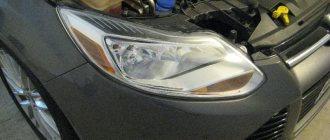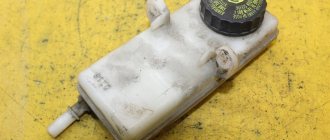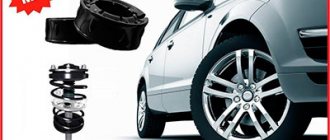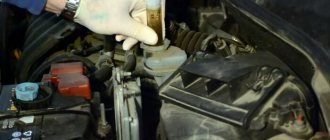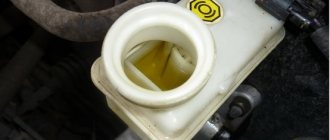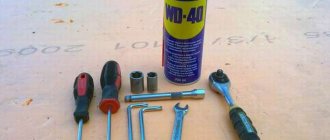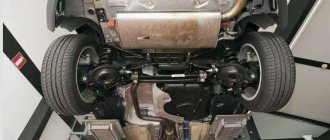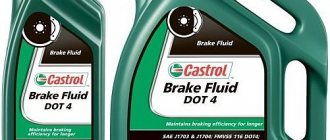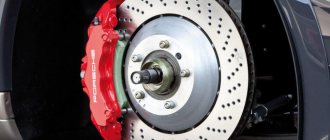If you start to notice problems with your car's braking, get it diagnosed immediately. The main reason for skidding and reduced brake efficiency is poor-quality or expired brake fluid.
The shelf life of the TJ is no more than two years from the date of replacement. It is advisable to fill in new fluid every forty thousand kilometers. Even if at first glance it seems clean and fresh, its performance characteristics noticeably decrease over time.
Replacement may also be required if the brake fluid level sensor shows a low reading. Brake fluid leaks if the integrity of the brake cylinder, hose or reservoir is compromised.
We remind you that storing TJ for Ford Focus 2 in open containers is strictly prohibited, since this composition is hygroscopic.
Purpose of brake fluid
Brake fluid is one of the most important consumables for vehicles with a hydraulic braking system. TJ is used in closed loop systems and is under the highest pressure.
The requirements for manufacturers have been increased not only because ride comfort depends on the quality of the composition. A vehicle that does not meet standards has a negative impact on the safety of movement. The use of such liquid can lead to an emergency on the road.
The fuel fluid is poured into the contour brake system. Due to it, a force is created that allows the pistons on the rear and front brake calipers to work smoothly.
Checking the level and adding hydraulic fluid to the power steering reservoir
When repairing the brake system, or even the entire car as a whole, promptly replace the brake fluid with fresh one. It is very hygroscopic and absorbs moisture from the air, which, in addition to causing corrosion of brake system parts, lowers the boiling point of the fluid itself, and this can lead to brake failure during frequent heavy braking. Do not reuse the fluid drained from the system: it is contaminated, saturated with air and moisture. If brake fluid gets on wires, plastic or painted body parts, it can cause damage, so always use clean rags when filling. If liquid gets on these parts, wipe them immediately with a clean cloth.
1. Check the brake fluid level in the reservoir. It should be located between the “MIN” and “MAX” marks marked on the tank body.
2. If the fluid level is below the “MIN” mark, unscrew the reservoir cap.
A gradual decrease in the brake fluid level in the absence of leaks most likely indicates the need to replace the brake pads. Check the condition of the brake pads (see “Checking the degree of wear of brake pads, discs and drums,” page 78). Untimely replacement of pads leads to expensive repairs (replacement of brake discs, drums, calipers)!
Brake fluid selection
The type of working fluid directly affects the efficiency of the brake system, since the quality of the components in the composition varies.
Types of brake fluids differ in viscosity and maximum boiling point. The viscosity of the composition depends on the system in which it will be used. It is important that the composition meets the basic established standards. That is why before purchasing, do not forget to read the manufacturer's requirements.
For example:
- For Ford Focus 2 models produced before 2007, glycol-based formulations are used. These include Ford SA-M6C9103-A DOT-4, as well as Ford ESD-M6C57-A DOT-4 super.
- For cars produced from the spring of 2007 to the summer of 2011 (restyled), fluids were used, the factory specification of which is designated as WSS-M6C65-A2, DOT 4 LV.
In total, a complete replacement will require about 1.5 liters of brake fluid. Please note that before purchasing a TJ, you must carefully check its packaging. Protect yourself from buying counterfeits:
- Carefully inspect the packaging and make sure that it has the factory marking (part number), brand name, and composition.
- Check the sticker on the canister with images on the Internet. Its color, as well as the arrangement of elements on it, must correspond to the original. The label should not contain any extraneous inscriptions or images.
Original liquids are often counterfeited. Unfortunately, it is not possible to guarantee that a fake TZ will function correctly in the vehicle system.
vehicle vehicle
You will be interested: How dangerous is the new coronavirus?
Alarm bells ring for the car owner: braking efficiency is steadily decreasing, and skidding intensifies when cornering.
The first thing you need to do is look under the hood to make sure everything is in order with the contents of the expansion tank. The brake fluid level in the Ford should be at about.
In cases where the instrument panel indicates a low level in the master cylinder, there is no need to rush to add it to the system. The warning may also apply to the operation of the pads. To check the degree of wear, it is necessary to measure their thickness and degree of wear and, if necessary, replace them.
Certified Focus showrooms recommend updating the contents of the expansion tank once every two years or upon reaching 40 thousand kilometers. In any case, when the critical period approaches, you must make sure that it is in good condition and has not lost its ability to absorb water from the surrounding atmosphere. Excessive moisture damages internal components and pipes and corrodes the brake cylinder.
Original
Most motorists prefer to purchase original consumables. The following TCs are currently used on Ford Focus 2:
| Name | Class | vendor code |
| Dot 4 Ford SA-M6C9103-A | DOT4 | 1 850 522 |
| Super Dot 4 Ford WSS-M6C57-A2 | DOT 5.1 | 1 776 311 |
| Dot 4 LV High Performance Ford WSS-M6C65-A2 | DOT 6 | 1 847 947 |
Keep in mind that the cost of original brake fluid is in the range of five hundred to six hundred rubles per liter. It's quite expensive. That is why you may want to consider purchasing an analogue one.
Among the reasons for purchasing an original TZ, car owners highlight:
- guaranteed safety of using the vehicle;
- high quality liquid;
- long service life regardless of operating conditions;
- high braking efficiency.
The only significant disadvantage is the cost. A complete replacement of brake fluid will cost you 1000-1200 rubles, since the volume of brake fluid on the FF2 is 1.5 liters.
Principle of analogue selection
The minimum standard for this line of cars is DOT4. Of course, this is not the only selection criterion. Pay attention to the composition: most manufacturers produce liquids on different bases. Mixing glycol and mineral TFs is unacceptable even if they are both produced according to the same standard.
The average cost of similar brake fluids varies from 250 rubles per liter. According to tests conducted, as well as reviews from car owners, most Ford Focus owners use the following compounds:
- TOTAL HBF 4;
- Castrol DOT4;
- Tutela Top 4;
- Hi-Gear HG7044;
- SINTEC Euro;
- ROSDOT 4 Life Safety.
Please note that cars with brake systems designed for mineral fluids do not tolerate glycol compounds well. Glycol-based fuel fluid will render the entire system unusable.
You can see the composition of the brake fluid on the packaging. Check that the sticker has Ford tolerances. If they are absent, it is better not to take risks and consider another option.
TOP 3 motor oils according to ford96.rf recommendations:
Ford Formula F 5w30 5l. The lubricant is designed specifically for Ford vehicles. This is a hydrocracking synthetic. Produced through special distillation and ultra-thorough purification. The product is not inferior in performance parameters to PAO synthetics. The composition prevents the deposition of carbon deposits on surfaces and the appearance of corrosion, and is perfect for regions with frosty winters. In the heat it does not liquefy and does not burn. Ford Formula F 5w30 5l increases engine efficiency, suitable for any Focus 2 models. It can be selected for cars with 1.6 100 hp. and cars with 2.0 145 hp. A 5-liter canister is the optimal volume to completely change the lubricant.
How to fill TZ correctly on Ford Focus 2
So, you have already purchased a new container of brake fluid and made sure that it is suitable for use on FF2. Let's start replacing it:
- Remove the barrel cover protecting the brake master cylinder.
- We get rid of the protective rubber caps located on the air release valves from the wheel cylinders.
- We put rubber hoses on the air release valves. We lower their other ends into any convenient glass vessel.
- We turn both valves one turn and drain the fluid by pressing the brake pedal. We drain it from glass containers.
- We pour new fuel fluid into the barrel of the master cylinder. Turn the air release valves back one turn.
- Press the brake pedal as hard as possible so that fresh fluid fills the system. Don’t forget that you need to add fuel fluid to the master cylinder reservoir.
Even a beginner can handle this procedure. In order to change the fluid, you do not need to go to a car dealership. The only rule is to remember to follow safety precautions.
Bleeding Ford Focus brakes
How can you tell if your brake system needs bleeding? If you notice at least one of the following symptoms, we recommend contacting a car service:
Trust bleeding of the brake system only to professionals!
WHEN SHOULD YOU BLEED YOUR FORD FOCUS BRAKES?
Bleeding the brakes - removing air - may be necessary for several reasons:
- The brake system of a Ford Focus was repaired with the main pipes disconnected, that is, airing occurred: hoses and pipes were replaced, the master cylinder or vacuum booster was dismantled, and brake tuning was carried out.
- Depressurization has occurred - damage to the brake fluid lines.
- Ford Focus brake fluid was replaced.
- The brake fluid level in the expansion tank has dropped to a critical level.
HOW TO KNOW THAT THERE IS AIR IN THE FORD FOCUS BRAKE SYSTEM?
When the brakes are aired, the driver’s sensations when pressing the brake pedal change noticeably:
- The braking distance increases noticeably.
- The stop occurs in jerks.
- Pedal travel also increases.
- The Ford Focus brake pedal becomes unnaturally soft, “cotton-like”.
WHAT BRAKE FLUID SHOULD BE FILLED INTO THE Ford Focus SYSTEM?
There are four grades of brake fluid: DOT 3, DOT 4, DOT 5 and DOT 5.1. As a rule, the car system uses a glycol-based composition - DOT 3, DON 4 and DOT 5.1. DOT 5 is made on the basis of silicone, which is not able to absorb moisture, but during operation it is saturated with air, which is unacceptable for ABS, ESP and other electronic braking systems. To understand what kind of fluid is in the brakes of your car, just look at its color: glycol is yellow, silicone is red.
Mixing silicone and glycol fluids in the Ford Focus brake system is unacceptable! You should also not add fluid that is not intended for this purpose to a composition intended for brakes with ABS. Mixing DOT 5.1 or DON 4 with DOT 3 results in a significant reduction in the boiling point of the brake fluid.
If you do not know what kind of fluid is in the brakes of your car, it is recommended to inspect the hoses, tubes and connections for leaks, and then completely replace the fluid and then bleed the brake system.
IS IT POSSIBLE TO BLEED THE FORD FOCUS BRAKE SYSTEM IF IT IS EQUIPPED WITH ABS AND ESP?
It is not recommended to bleed Ford Focus brakes with ABS yourself. When the valve block and hydraulic accumulator are of the same design, it is enough to disable the ABS system, but if these elements are located in different places, additional knowledge and a professional scanner, which is only available in car services, will be required. The same applies to cars with ESP.
WHAT IS THE PROCEDURE FOR BLEEDING BRAKES FOR A FORD FOCUS?
Before starting the process of pumping the brakes, be sure to check the volume of fluid in the reservoir - it should be at the maximum level. You should also unlock the pressure regulator located on the rear axle and clean the air bleed valves on each caliper.
The standard algorithm for bleeding the Ford Focus brake system requires starting the procedure with the rear right wheel, then starting with the rear left, then working with the front right and finishing with the front left. However, it is worth familiarizing yourself with the sequence in the service book of your car. If such data is not available, then the standard approach described above is applied.
ERRORS WHEN SELF-BLENDING THE Ford Focus BRAKE SYSTEM.
Car service technicians have more than once had to repair a Ford Focus after the car owner had pumped the brakes himself. As a rule, there are three typical errors:
- A fluid is added to the brake system that does not match the one that is already filled. This leads to destruction of the rubber seals and, as a consequence, depressurization. Repair stages: replacement of all rubber elements, replacement of Ford Focus brake fluid, re-bleeding the brakes.
- Allow the brake fluid level to drop below the minimum value. Many people forget that during the bleeding process, brake fluid must be constantly added to the Ford Focus reservoir, otherwise air will enter the system again. Repair steps: add fluid to the system, re-bleed.
- Exceed the pressure in the tank to critical. The recommended pressure should not be higher than 0.8 Atm, otherwise the tank will burst. Repair stages: replacing the Ford Focus tank, adding brake fluid to the system, bleeding the brakes.
WHAT TO DO IF THE Ford Focus BRAKE BLEEDING FITTING IS BROKEN?
Let's look at the reasons for valve failure:
- The fluid had not been changed for a long time, which means the system had not been pumped for a long time, which caused the valve to jam.
- During work, the fitting was clamped too tightly.
- The valve is corroded.
The piece of fitting is removed by drilling or welding on an auxiliary element. If the reason is oxidation, it is worth inspecting the entire Ford Focus caliper for wear: perhaps replacing the assembly part will be relevant.
